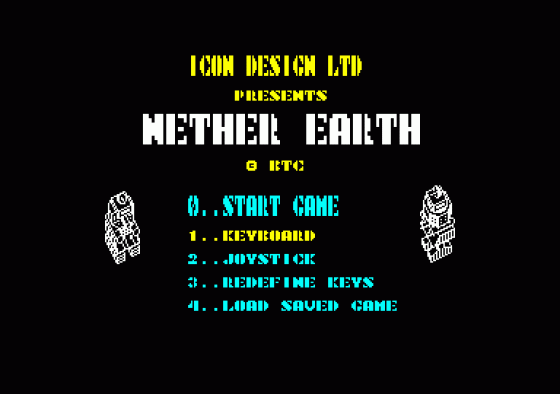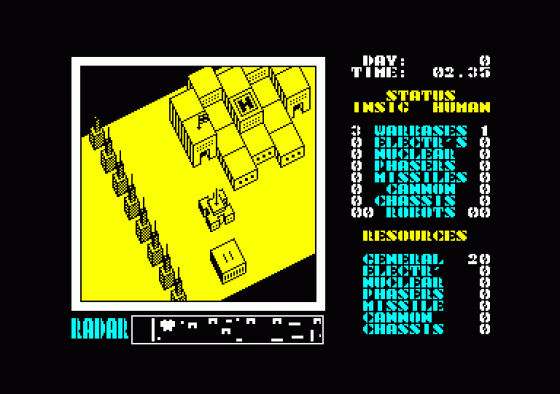Nether Earth
Games requiring mental dexterity are definitely flavour of the month, and about time too. I've always enjoyed the type of game where a long, hard struggle always occurs and a well-considered battle plan is required. This continues the run of much-improved Argus Press games, perhaps a result of a more considered battle plan on the part of Argus.
The game takes place on a long, scrolling, narrow strip of land. You start at the western edge and it runs upwards and off to the east, to where the enemy are positioned many screens away. You control an anti-grav unit which can fly freely along the map. You may think you've stumbled into a Zaxxon rip-off at this stage. Such is not the case. A quick trip to the top of your headquarters building will reveal that fact.
The HQ is your warbase and the nearest building at the start. Scattered all along the strip of land are other buildings and features including factories, walls, hills and crevasses. Everything except the factories serve just as obstacles to your later activities. Further up the strip are three enemy warbases. Your aim is to capture or destroy all of these.

Landing on the HQ takes you to a screen where you can build robot war-machines. These can be made up of various modules. First are the three types of chassis unit, then four types of weapon and an electronic module. The chassis types are bipod, tracked and anti-grav, which have different capabilities for coping with the terrain and of course different costs.
To produce the units you have to allocate limited resources. This applies to the other modules as well, so you have to balance the cost of the unit against its effectiveness and task. To start, you'll have very little to play with, so very basic robots of a chassis and one weapon will probably suffice.
The weapons are cannon, missiles, phasers and nuclear. They have different ranges and power, the nuclear bomb being very expensive and used for blowing up factories or warbases. Once a robot is built you can despatch it into play.
Outside the war base the robot will halt until you fly on to the top of it and give it some orders. You can either have the robot under direct control or as will nearly always be the case, give it orders to carry out on its own. You can tell it to stop and defend a spot, advance or retreat a specified distance, destroy robots, factories or warbases, or capture factories and warbases.
The factories are the most important feature: once they are under your control they can produce more resources with which you can build robots. However, the enemy will also be acquiring factories to build up their own army of robots. At the outset, the factories near you will be neutral and you'll have no enemy interference. You need to capture these quickly and try to build a force that can fight back against the now invading enemy robots.
Just holding the enemy off will be tough enough. Attacking their factories and war-bases requires real forward planning, good marshalling of resources and a smidge of luck. The fact that you play general and leave the robots to do most of the work on their own is what really forces you to think through what they've got to do. You can directly control one robot at a time for both moving and combat, which is useful for some situations where a specific task is required.
The robots exhibit just enough intelligence to perform their tasks without actually making your decisions for you. If left entirely to their own devices after leaving the warbase you'll lose. You can only play against the computer but it's a formidable enemy.
When robots clash one will be destroyed, depending on who has the better weaponry and location, leaving a pile of junk where used to be a hi-tech battle machine. Controlling these encounters is the most important task. The computer's built-in warbase advantage means you have to destroy its robots while maintaining yours - there is a way.
The robots and landscape are drawn in some detail but - and I'm getting tired of saying it - the use of colour is awful again. Just yellow and black for the playing area and robots. It isn't particularly hard to produce good colour on the CPCs so why can't Argus Press? Apart from that it's an excellent game, a nice piece of future strategy that will provide many hours of fun.
Second Opinion
Although the game is slow-moving - or rather, the graphics (in particular your robot) take an age to get from one place to another - there is an enjoyable element of puzzling. It is along similar lines to Mission Omega but thankfully does not put you to sleep.
Green Screen View
No problems.
First Day Target Score
Capture nine factories.
Verdict
Graphics 72%
P. Detailed playing area and robots.
N. Why the lack of colour?
Sonics 53%
P. Good title tune.
N. Few in-game effects.
Grab Factor 80%
P. You take decisions while the robots do the boring bits.
N. Lack of colour and awkward instructions confuse things.
Staying Power 82%
P. Tough computer opponent.
N. Large, well-designed play area.
Overall 80%
P. Good to see a future-based strategy game.


 1st June 1987
1st June 1987











